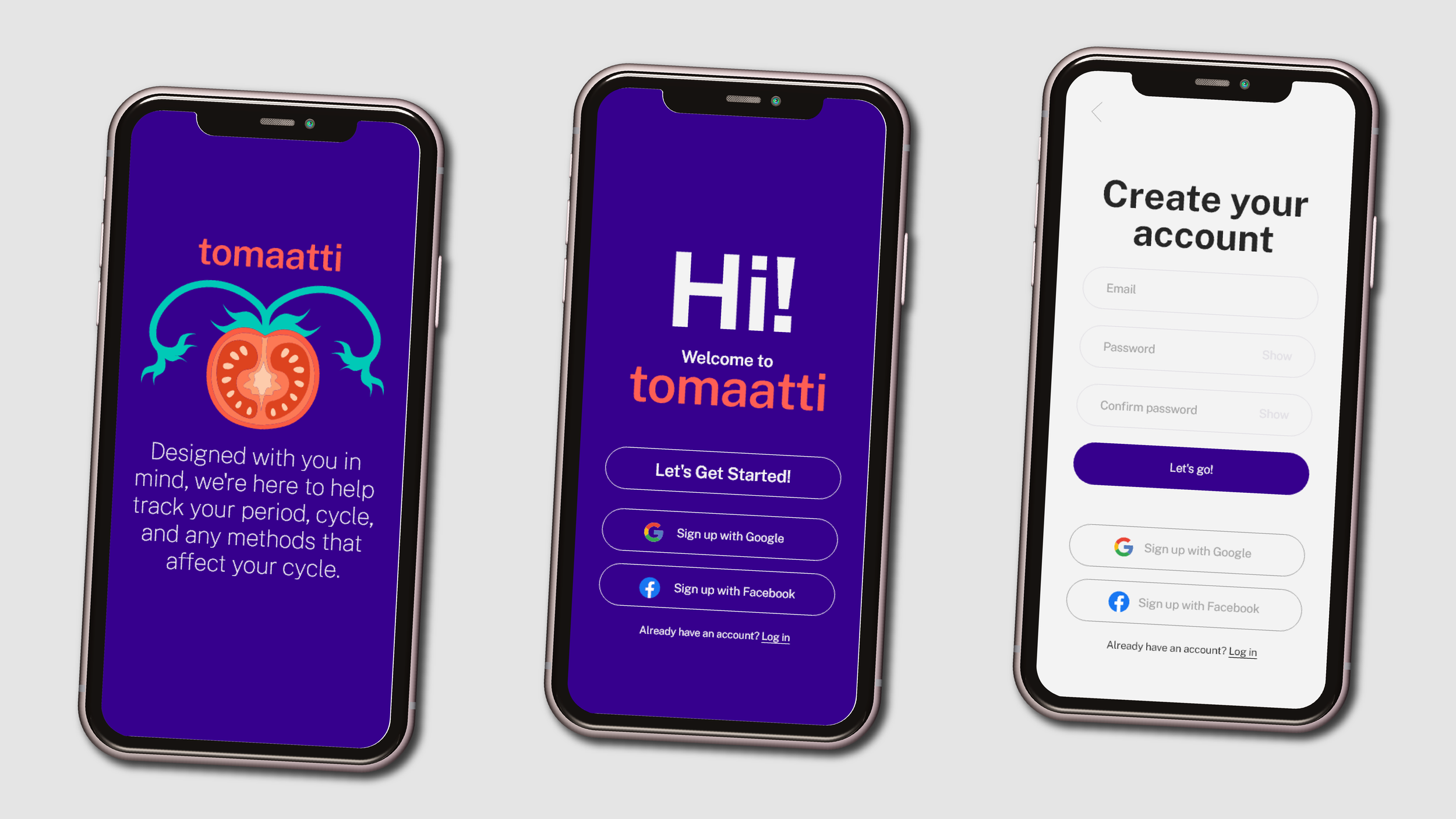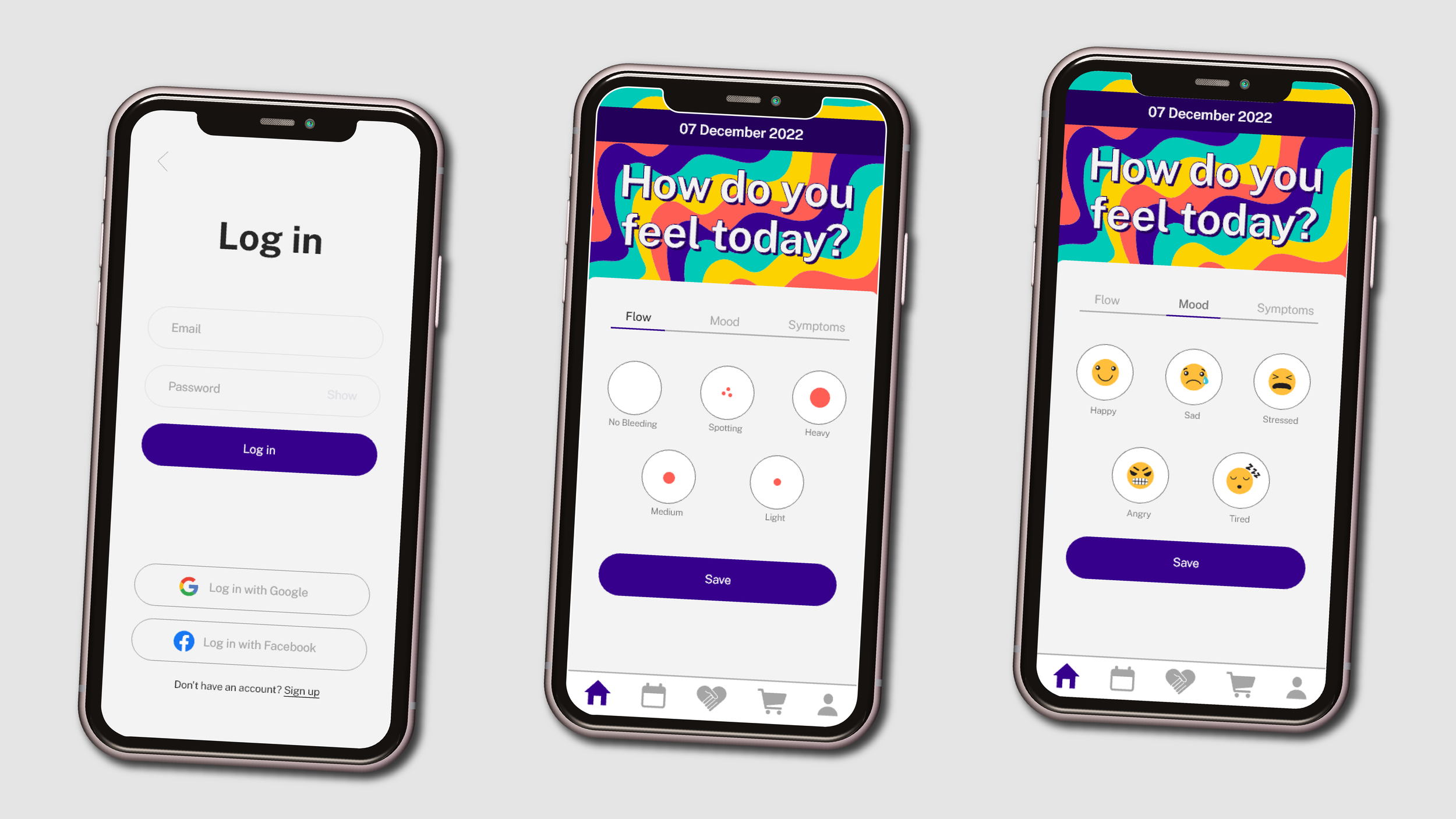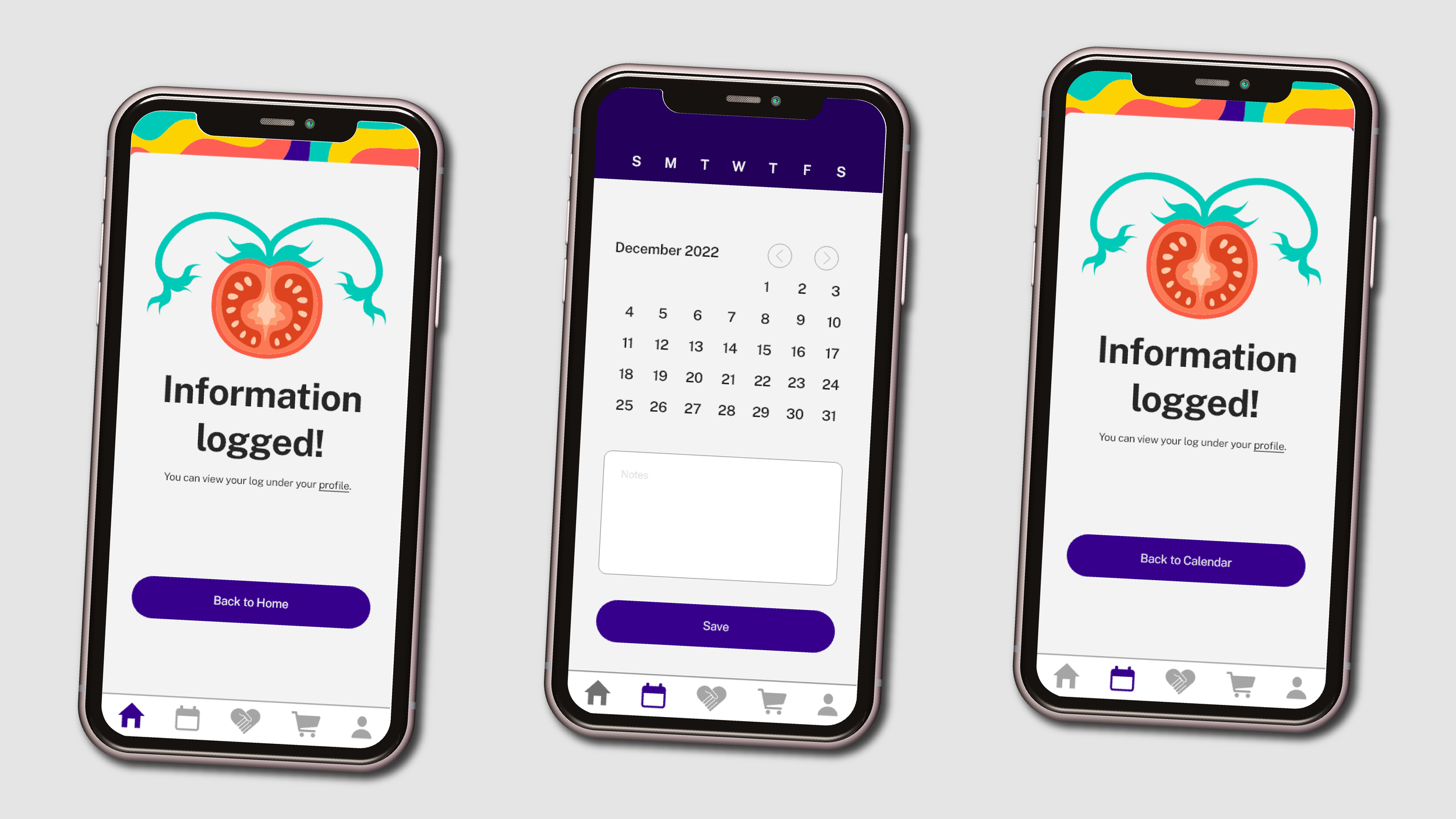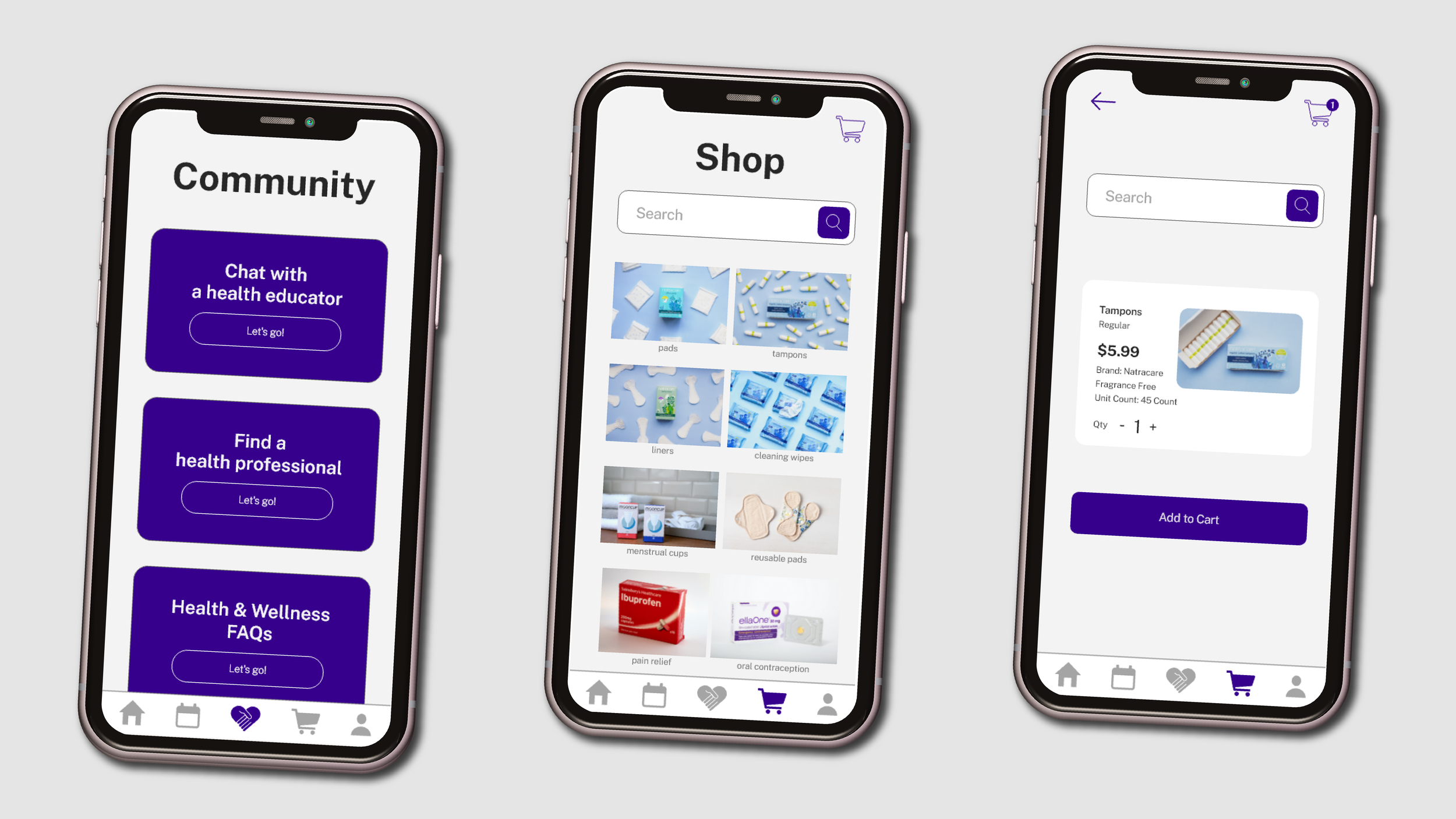Tomaatti
Redefining Period Tracking for All Identities
Tomaatti is a period-tracking app that promotes gender equality and body autonomy using gender-inclusive language, providing trans and genderqueer individuals with information and resources to navigate menstruation without isolation or discrimination.
The Challenge
I aimed to address the definition of gender-inclusive language and its application in period-tracking apps to promote gender equality, exploring how such apps can empower individuals regardless of their gender identity.
MY ROLE
Product Designer
UI/UX Designer
UX Researcher
TOOLS
Adobe XD
Figma
Illustrator
Photoshop
PROJECT SCOPE
Gender-Inclusive Period Tracking
Body Autonomy Empowerment
Accessible Menstrual Information
Community Support
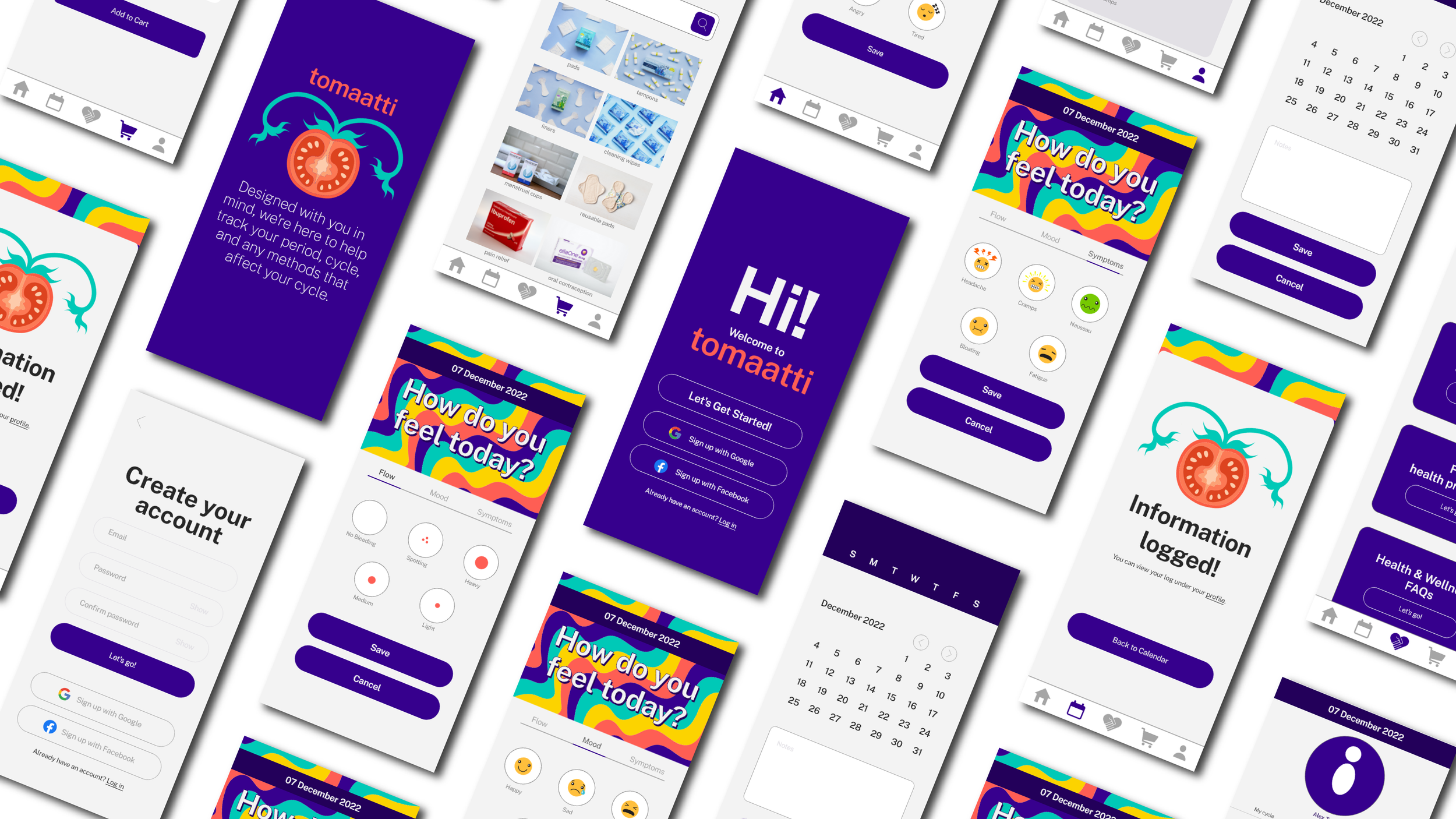
User Research
I interviewed six participants, including two nonbinary and one trans man, and shared a questionnaire on a public forum for additional input on the health-related topic. Structuring discussions to center around gender-inclusive language, I prioritized privacy and avoided gathering personally identifiable information.
Participants emphasized that gender equality means providing opportunities and resources regardless of gender, noting its positive impact on community safety, health, and happiness. Recognizing gender diversity beyond a binary perspective, many pointed out the oversight in traditional period-tracking apps, which assumed a feminine user.
My user research identified a need for addressing period poverty and enhancing accessibility to sexual and reproductive health information, period products, and supportive communities. Consequently, I aimed to design an inclusive app that uses appropriate language and imagery and offers comprehensive tracking features for various health symptoms beyond fertility indicators.
Primary Users
Age Group
27-52 Years Old
Gender*
50% Women, 33.3% Non-Binary, 16.7% Men
*Based on the number of interviewees who willingly identified their gender.
Period-Tracking Reasons
Symptom tracking, understanding general health, predicting period start date
Secondary Users
Age Group
14-26 Years Old
Period-Tracking App Usage
2+ Years
Period-Tracking Reasons
Fertility indicators and using the app as part of a regular health check-up routine
How can a period-tracking app foster gender equality, empower users irrespective of their identity, and destigmatize menstruation?
Market Research
Secondary research identified market gaps in addressing users' needs for an app that addresses sex education, fosters open discussions on menstruation through a community forum, and discreetly delivers period products and birth control through an online shop. After a competitor analysis, while considering users' preferences, I aimed to fill these gaps by creating Tomaatti.
Clue
Pros
- Tracks period flow
- Tracks menstrual cycles
- Info database
- Provides community resources
Cons
- No symptom tracking
- No calendar reminders
- No online shop
Eve
Pros
- Tracks period flow
- Tracks symptoms
- Tracks menstrual cycles
- Info database
- Provides community resources
Cons
- No calendar reminders
- No online shop
Flo
Pros
- Tracks period flow
- Tracks symptoms
- Tracks menstrual cycles
- Calendar reminders
- Info database
Cons
- No community resources
- No online shop
Magic Girl
Pros
- Tracks period flow
- Tracks symptoms
- Tracks menstrual cycle
- Calendar reminders
- Info database
Cons
- No community resources
- No online shop
Ovia
Pros
- Tracks period flow
- Tracks symptoms
- Tracks menstrual cycles
- Info database
- Provides community resources
Cons
- No calendar reminders
- No online shop
My research identified a need for addressing period poverty and enhancing accessibility to sexual and reproductive health information, period products, and supportive communities. Consequently, I aimed to design an inclusive app that not only uses appropriate language and imagery but also offers comprehensive tracking features for various health symptoms beyond fertility indicators.
From the competitor analysis, I concluded the app should have the following key features:
User Persona
User Flow
I defined the app's features and created a user flow showcasing its all-in-one offering, including an online store discreetly delivering various period products, while also using gender-neutral language to support users in their menstrual journey without alienation.
Ideation & Lo-Fi Wireframes
After identifying my target audience and their needs, I created initial low-fidelity wireframes that informed high-resolution versions and facilitated early usability tests.
Mid-Fi Wireframes
The initial lo-fi wireframes and revised mid-fi wireframes guided my hi-res versions and enabled early usability tests, revealing crucial revisions needed.
Key Revisions Needed & Solutions
Revision Needed: Initial consolidation and user resource hub.
Solution: Shop, community forum, and professional care were grouped under the "Services" page, aiming to provide users with all necessary resources in one area.
Revision Needed: Clarification of terminology.
Solution: The term "services" was deemed too vague, prompting the decision to create more distinct categories.
Revision Needed: More structured organizational division.
Solution: I decided to create two distinct pages - "Community/Resources" and "Shop."
Logo & Branding
Using insights from market research, I created a mood board to inspire ideas for a gender-inclusive brand, prioritizing avoiding labels and traditional gender themes, opting for bold, neutral colors, and simple, readable, web-safe fonts.
I named the app Tomaatti, the gender-neutral Finnish word for “tomato” and a euphemism for “period.” The logo, featuring a tomato on an equal-sided triangle, symbolizes cervical health, supported by Dr. Jelani D Ingram's research that tomatoes are also one of the top “superfoods” that “support cervical health” (2020). The gender-neutral colors (green, yellow, purple) and the font choice, Public Sans, aim to create a welcoming brand promoting menstrual and cervical health for all users.
UI Kit and Branding Style Guidelines
Hi-Fi Wireframes
Prototyping
Usability Testing
I tested the initial prototype with three users, identifying key pain points for improvement in the iteration.
Key Revisions Needed & Solutions
Revision Needed: Difficulty reading the "How are you feeling today?" sentence on the wavy background.
Solution: Explore simpler backgrounds or alternative text stylization.
Revision Needed: Low color contrast issues in certain grey areas.
Solution: Ensure uniformity of the main navigation bar across all pages.
Revision Needed: Log-out button redirecting users to onboarding pages, creating an extra step during login.
Solution: Verify compliance with minimum WCAG AA standards for light grey text in small sizes.
Despite these challenges, test users appreciated the app's gender-neutral language, style choices, and the inclusion of a community page and online shop, aligning well with the target audience's needs.
Reflection: Takeaways & Next Steps
Breaking Barriers & Revolutionizing Menstrual Wellness: Redefining Period Care Accessibility and Healthcare Equality
The future of design should embrace gender inclusivity, revealing an increasing demand for not just period-tracking apps that aren't gender-specific, but also accessible resources such as information, health professionals, and period products. It emphasizes the importance of users feeling seen, heard, safe, comfortable, and secure in managing their physical health during their menstrual journey.
I learned that being "gender inclusive" doesn't necessarily equate to being "user compliant." Ensuring accessibility for users with disabilities through thorough compliance testing is essential in design. Moving forward, I plan to prioritize meticulous attention to accessibility compliance in all my designs.
This design has significant potential to impact users and businesses dealing with menstruation, addressing issues like period poverty and lack of sexual and reproductive health education. With further development and research, the app could serve as a crucial link, connecting users to affordable care and resources, ultimately fulfilling a fundamental human right.


